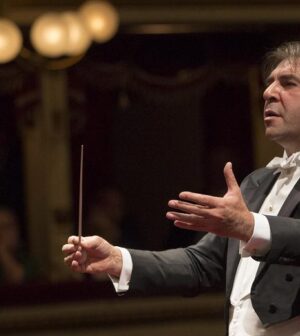by Olga Chieffi
After an “extra-cultured” appointment, dedicated to French film music and the performance of Enzo Avitabile, tomorrow evening we return to the Verdi theater, at 8 pm, for the concert of the Mozart Orchestra conducted by Daniele Gatti, at the head of a international artistic project of great originality and value, a formation composed of first parts coming from the main orchestras and young talents from all over the world. The evening will be inaugurated by “Metamorphosen”, a study for 23 solo strings by Richard Strauss, mysterious and spiritual music, similar to Wagner’s Tristan, which in its mysticism also contains some nuances of Mahler. Epitaph on German and European culture the page is a sort of immense post-Brucknerian adage, born on the emotional wave of the bombing of Bavaria on 2 October 1943, during which, among other things, the Staatsoper was destroyed. In the rich and ductile sound material it is possible to identify three major motivic cells, always subjected (with the minor ones) to processes of transformation, of ‘metamorphosis’. Furthermore, in the three cells, the creative imagination has evoked, first in fragments, then in full, consciously, two impressive quotations, from the Funeral March of the Heroic Symphony and from the ‘lament’ of King Marke in the second act of Tristan, symbol of disappointment and the desperation of betrayal. The surprising novelty of the ensemble, which evokes a baroque ensemble, 10 violins, 5 violas, 5 cellos, 3 double basses, does not hide, as some have mistakenly believed, a quintuple amplification of the traditional string quartet with three added basses, instead it is due to the solo responsibilities of each instrument or small groups of instruments in turn. The enigmatic title certainly does not allude only to the technique of thematic transformation, but points to the reflections of mature Goethe on the metamorphosis of nature, recalls the beloved classical myths, and perhaps tries to squeeze a hope in affliction and dismissal. In the second part of the evening we will be part of that dream that unravels from the third symphony in E Flat major, Op.55 by Ludwig van Beethoven, never so relevant and necessary as today: equality, freedom, fraternity. Composed thinking of the figure of Napoleon Bonaparte, who for Beethoven, as for Hegel, embodied the spirit of the time (a revolutionary, democratic spirit), this symphony is a celebration of history as an epos of the present. The narration takes place in a non-linear way, through flashbacks and leaps forward, and seems to be conceived as a commentary on invisible images, but certainly vivid in the minds of the listeners. And in fact this is perhaps the most “visual” of Beethoven’s symphonies: it works almost like a soundtrack. This is how it is from the first movement, almost a theme built around the very simple reason for waiting for something great, even if, in the development, a sweet “theme” peeps out – outside the couple of main themes – which seems to express what everyone after all, one hopes for a revolution: how happy life will be, afterwards, until the last time, in which the form of variations is adopted instead of the sonata-form: a succession in alternation of very different pictures, which makes of this movement an attempt to reconcile, rather than a couple, a plurality of opposites – the tensions and contradictions of an entire historical season. In the funeral march the use of elementary materials taken from public music (marches, hymns) conceived in France in the revolutionary period should be noted; these elements are absorbed in a “high” context, related to stylistic features of art music including the esoteric fugato technique, mobilized not for the purpose of a rarefied abstraction, but to dramatize the musical discourse and lead to the emotional climax of the movement in the next heartbreaking triplet episode. A lack of elaboration of the mourning finally finds voice in the impressive dismissal, where the theme of the funeral march is literally shattered, to express an annihilated prostration, without recomposition. The references to Virgil and Homer are not accidental because the Eroica was defined by Rolland as the “Iliad of the Empire”, with all the implications of the Napoleonic myth captured at the apex of the ascent and in the decomposition of the funeral. In the Finale (Allegro molto), built through the variation of a harmless theme taken from the ballet Le creature di Prometeo, there is also a sublime interlude (Andante); then, before the recapitulation (Presto), the remembrance of the funeral march returns. “The hero costs many tears – recalled Berlioz – after these last regrets offered to his memory, the poet leaves the elegy to intone the hymn of glory with enthusiasm”.
Comment this news on Facebook
Recommend
Daniele Gatti and the spirituality of Metamorphosen | Chronicles Salerno



